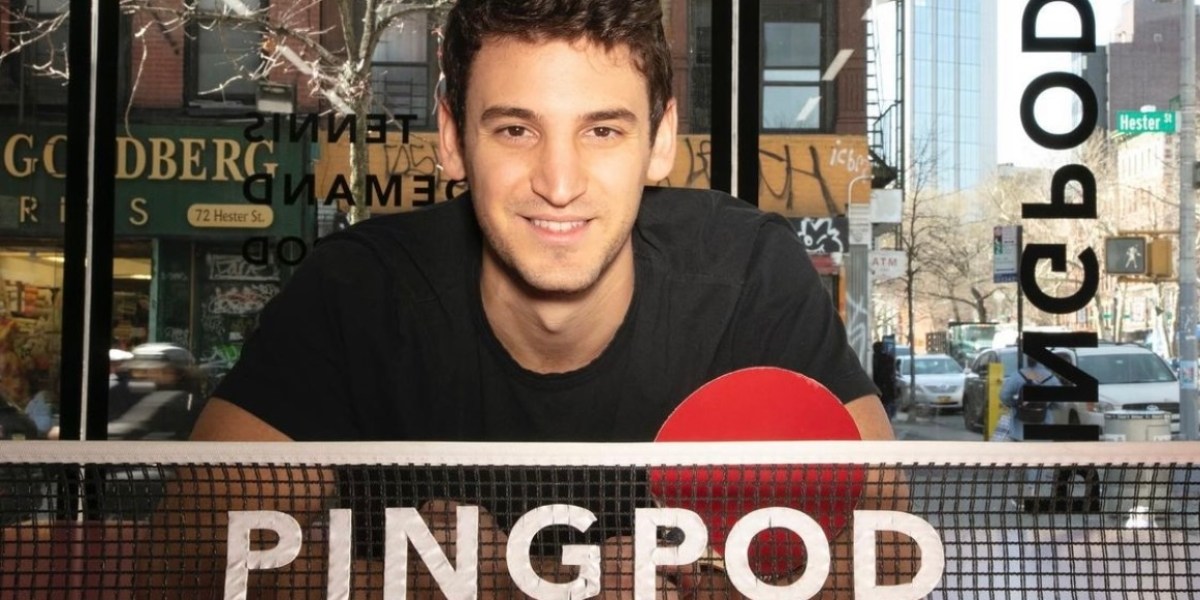
In 2019, I was working as an equity research analyst at UBS. I am an avid ping pong player, but when I moved to New York City I learned how difficult it was to find places to play. That’s when I had the idea for PingPod: 24/7 on-demand ping pong facilities that could operate without the need for full-time employees on-site.
We live in a world where experiences are valued over goods—aka “the experience economy.” Today the majority of Americans prioritize experiences over goods and products. But it can be expensive and complex to deliver experiences to people, especially in urban areas. Our autonomous operating model offers the technological key to creating more ping pong supply in urban markets—and it works for other sports, as well.
We started with a single PingPod location in the Lower East Side of Manhattan—the template for the 18 (and counting) U.S. PingPod outlets that would follow.
Here’s how they work: Rather than having staff man a location, everything on-site is automated. Users book the space with an app, and they can only unlock the door via a code on their smartphone. (For security we tap into another trend: outsourcing. See below.) The autonomous model not only cuts down on cost, but also expands the times of day a venue can be used.
Our focus was to create the best consumer experience possible. We built from scratch the software stack that powers PingPod. We always believed that one day we could license our system to outside venue operators. Last year, we bundled our technology assets into a wholly owned software-as-a-service (SaaS) subsidiary called PodPlay Technologies.
Today, PodPlay has over 70 venues (including the 18 PingPod outlets) signed up on the system across table tennis, billiards, baseball batting cages, pickleball, padel, soccer, golf simulators, racing simulators, and more. Any venue that sells reservation time slots is a potential PodPlay client. As it happens, there are many like-minded entrepreneurs in the sports and recreation space who are interested in running their venues in a labor-light fashion.
What started out as a single automated ping pong facility has transformed into a sports-tech company in which we are franchising the PingPod brand and licensing the PodPlay system.
In March 2022, we received $10 million in VC funding to help with our expansion. Last year, we reached $3.6 million in revenue, and this year we expect to hit about $6 million. Based on the most recent round of financing completed last year, our valuation is around $50 million.
Here’s how we’ve proven success and maintained the magic in the experience as we’ve scaled:
Modernize tech in urban spaces
PingPod has “Pods” in New York City, New Jersey, Philadelphia, Miami, Boston, and Chicago, with satellite locations in the U.K. and the Philippines. The autonomous operations powered by PodPlay enabled that rapid scale.
The desire for experiences combined with the fact that millennials, Gen Z , and Gen Alpha live in a digital-first world means we can anticipate more retail spaces in urban environments turning into experience-focused venues.
Before PingPod, the table tennis market in NYC offered two options: your giant “eatertainment” facility designed for F&B consumption, or your basement-style “dojo”—a specialized place for table tennis—that hasn’t been renovated since the ’90s.
PingPod is an avenue in between—a comfortable place to play ping pong that is affordable, accessible, and convenient. Rather than a giant destination facility with 30 tables, we offer a dozen smaller-format locations physically dispersed throughout a city.
Reduce operating costs
Operating autonomously or semi-autonomously is a game changer for business owners. In addition to reducing labor costs, autonomous models also lessen the need for physical labor and therefore reduce capacity constraints. Most PingPods are open 24/7, 365 days a year.
The fundamental problem that the autonomous operating model solves is location unit economics. Rent is expensive in urban locations, but variable labor costs are often an even larger component of the cost stack. Autonomous models help to limit labor costs and allow the business to run with minimal staffing requirements.
What it boils down to is the double-whammy of reduced operating costs and greater capacity, which yields over 40% operating margins in our highest-performing Pods.
Maintain customer safety
Autonomous venues are designed to be as simple to operate as possible. The PodPlay system enables small facilities to be run by a single, dedicated owner-operator.
When we first started PingPod, there were valid concerns around safety and security. The safety of our customers is always our utmost priority, and we have devised multiple ways to ensure it. First, all PingPod doors are locked by default. The only way one can access the space is by having a reservation. Second, having a reservation means that you paid and that we have your credit card on file to account for any ancillary charges. Third, the PodPlay system includes a dedicated video-monitoring team based in the Philippines. The team in Manila constantly keeps eyes on all PodPlay autonomous locations and alerts local team members when necessary. Five years in, with dozens of locations and hundreds of thousands of reservation hours under our belt, we feel comfortable saying that the operating model works as intended.
Create a seamless customer experience and foster community
The autonomous Pods allow players to set the tone of their outing. By including fully integrated audio and visual components, the player experience can be “gamified.” PodPlay equips venues with instant replay and score tracking capabilities that create an elevated experience for professionals and casual players alike.
The instant replay feature in particular is transformative for both the customer and venue operator. It’s designed to let players capture great moments without taking them out of the flow of their game. They no longer have to set up a tripod, mount a phone, etc. With the touch of a button in the Pod, a replay is projected onto the table monitor and is emailed to the customer and also lives in their account.
How often do customers utilize the replay functionality? A lot. At PingPod, customers are on pace to press the button more than 100,000 times in 2024. The beautiful thing for the venue owner is that many of these videos end up on social media as players share their experiences with more potential users.
Since we launched PingPod, more than 100,000 customers have signed up and more than 260,000 hours of ping pong have been played at our Pods, connecting players with friends both new and old in their own communities.
Read more:
The opinions expressed in Fortune.com commentary pieces are solely the views of their authors and do not necessarily reflect the opinions and beliefs of Fortune.
Next to Lead: Get the strategies and insights you need to make it to the corner office, delivered to your inbox each week.
Sign up here.















